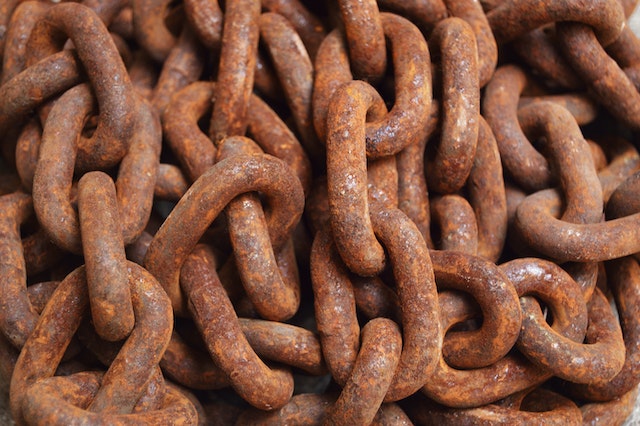
Why does iron rust? The iron atoms react with oxygen molecules to produce iron oxide, which is rust. Other metals don’t rust because only iron, or metals with an iron alloy can rust. This is because rust is iron oxide. Other metals can react with oxygen in different ways or corrode, but only iron can rust.
Rust requires more than just iron and oxygen. There must be water in the equation. If you put metal in dry air, or in the vacuum of space, it will not rust. A car left in a desert for fifty years will not have rusted. A car left in a rainforest for fifty years will have completely disappeared. You need iron, water, and oxygen to make rust. 50% humidity is enough to start iron rusting.
Iron rusts when the iron molecules give up electrons to the oxygen molecules. They do this because oxygen has a very negative electric charge. All molecules want to be perfectly balanced in that they want the same number of protons as electrons. Protons are positively charged, and electrons are negatively charged. If something loses electrons and has more protons than electrons, it is positively charged. If something gains more electrons than it has protons, it is negatively charged. If an atom has the same number of protons and electrons, it has no charge and is balanced. If an atom is positively or negatively charged, it desperately wants to balance itself, either by gaining or losing electrons. Oxygen has 8 protons and it has 8 electrons, so it should be balanced, but 6 of the electrons are in an outer orbit and 2 are in an inner orbit. The oxygen atom needs 8 electrons in its outer orbit to be balanced, so it tries to get two more electrons from wherever it can. Because of this desire to get two more electrons, oxygen is a very reactive element and when it takes these electrons from something, it is known as oxidization. It happens everywhere: in metals and in our bodies.
This is where the iron and the water come in. Oxygen alone cannot get the electrons out of iron. It needs an electrolyte, which is a liquid or gel that contains ions. The electrolyte’s job is to transfer electrons. When water comes into contact with iron, it starts to dissolve the top layer of the iron. As it does this, the dissolving iron releases electrons and a small current is produced. The iron that is dissolving loses three electrons. One of these electrons connects to the hydrogen in the water, which balances it and breaks the oxygen hydrogen bond, freeing them both. The oxygen takes the other two electrons from the iron and the oxygen and iron bond into iron oxide, which is rust. The water continues to dissolve the iron and the iron and oxygen continue bonding until all of the iron is gone. Salt water and acidic water can increase the buildup of rust. This is because they are much better electrolytes and can transfer electrons at a much faster rate. An iron boat at sea will rust away far more quickly than an iron boat on land.
As the water continues to dissolve the iron and it changes into iron oxide, it becomes brittle and flakey, losing all of its strength. The more rust there is, the more there will be because it is a continuing process that supports itself.
The only way to prevent rust is to not use iron or to coat the iron in something. There are waterproof paints that will protect iron from rust. The iron can be covered in another metal. Galvanization is a common method of protecting against rust. Iron is coated in a layer of zinc and the zinc gets corroded instead of the iron. However, galvanization is not a perfect solution because once all of the zinc has been eroded away, the iron will be next. Passing an electric charge through the iron can also prevent rust because it stops the oxygen and the iron from bonding.
There are some cases where rust can happen without the presence of water. If the temperature is high enough, oxygen and iron will combine, forming rust. Also, the surface of Mars has rusted and there is no water there. The theory is that UV light from the sun hit the iron molecules and made them lose the electrons that started the process of rusting. And this is what I learned today.
Photo by Miguel Á. Padriñán: https://www.pexels.com/photo/brown-chains-114108/
Sources
https://www.thoughtco.com/how-rust-works-608461
https://byjus.com/chemistry/rusting-iron-prevention/
https://www.zrcworldwide.com/blog/what-causes-rust-in-metals
https://sciencing.com/salt-water-rust-metals-5150093.html
https://science.howstuffworks.com/question445.htm
https://www.corrosion-doctors.org/Experiments/rust-chemistry.htm
https://shishir-iyer.medium.com/why-is-oxygen-electronegative-61647c8a3ed
https://chemistry.stackexchange.com/questions/5134/why-cant-rust-form-without-water
